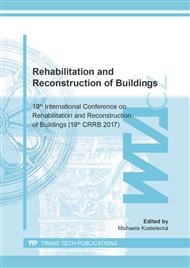p.51
p.55
p.59
p.66
p.70
p.76
p.81
p.86
p.92
Use of Computed Tomography for the Evaluation of Autoclaved Aerated Concrete Structure
Abstract:
This paper deals with the use of computed tomography (CT) images and analytical software for the nondestructive evaluation of the texture of autoclaved aerated concrete (AAC) with 20% fluidized bed combustion fly ash as a substitute for quartz sand. The samples of AAC, made in the laboratory with the same composition but different ways of curing in the fresh stage (before autoclaving), were subjected to observation of the differences in the texture of the silicate matrix, such as inhomogenity, defects, and pore size distribution. The curing conditions with limited drying resulted in formation of larger, locally-connected pores and additional cracking after autoclaving, which led to a decrease in compressive strength up to 1.32 MPa, compared to samples cured in conditions that allowed complete drying reaching 1.95-1.96 MPa. Also there were problems identified related to imperfect laboratory preparation of the samples, such as agglomeration of individual mixture compounds and larger air void formation, due to the absence of vibrating, cracking and weak spots formation. CT provided sufficient contrasting images for consequent software evaluation of pore size distribution, however a higher resolution of the images is needed for determination of pores smaller than 0,125 mm.
Info:
Periodical:
Pages:
70-75
Citation:
Online since:
August 2018
Authors:
Price:
Сopyright:
© 2018 Trans Tech Publications Ltd. All Rights Reserved
Share:
Citation:


